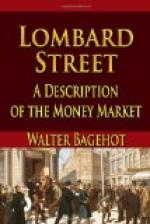This prosperity is precarious as far as it is real, and transitory in so far as it is fictitious. The augmented production, which is the reason of the real prosperity, depends on the full working of the whole industrial organisationof all capitalists and labourers; that prosperity was caused by that full working, and will cease with it. But that full working is liable to be destroyed by the occurrence of any great misfortune to any considerable industry. This would cause misfortune to the industries dependent on that one, and, as has been explained, all through society and back again. But every such industry is liable to grave fluctuations, and the most important—the provision industries—to the gravest and the suddenest. They are dependent on the casualties of the seasons. A single bad harvest diffused over the world, a succession of two or three bad harvests, even in England only, will raise the price of corn exceedingly, and will keep it high. And a great and protracted rise in the price of corn will at once destroy all the real part of the unusual prosperity of previous good times. It will change the full working of the industrial machine into an imperfect working; it will make the produce of that machine less than usual instead of more than usual; instead of there being more than the average of general dividend to be distributed between the producers, there will immediately be less than the average.
And in so far as the apparent prosperity is caused by an unusual plentifulness of loanable capital and a consequent rise in prices, that prosperity is not only liable to reaction, but certain to be exposed to reaction. The same causes which generate this prosperity will, after they have been acting a little longer, generate an equivalent adversity. The process is this: the plentifulness of loanable capital causes a rise of prices; that rise of prices makes it necessary to have more loanable capital to carry on the same trade. 100,000 L. will not buy as much when prices are high as it will when prices are low, it will not be so effectual for carrying on business; more money is necessary in dear times than in cheap times to produce the same changes in the same commodities. Even supposing trade to have remained stationary, a greater capital would be required to carry it on after such a rise of prices as has been described than was necessary before that rise. But in this case the trade will not have remained stationary; it will have increasedcertainly to some extent, probably to a great extent. The ‘loanable capital,’ the lending of which caused the rise of prices, was lent to enable it—to augment. The loanable capital lay idle in the banks till some trade started into prosperity, and then was lent in order to develope that trade; that trade caused other secondary developments; those secondary developments enabled more loanable capital to be lent; and that lending caused a tertiary development of trade; and so on through society.




